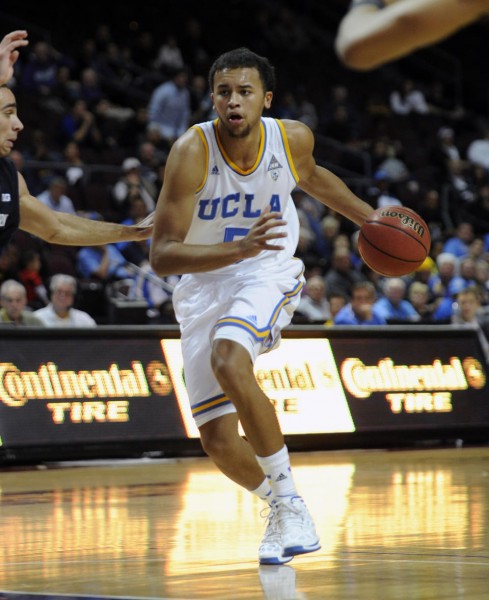Marching to Vegas: On Kyle Anderson and Offensive Efficiency
Posted by Adam Butler (@pachoopsab) on December 6th, 2013Adam Butler (@pachoopsab) of Pachoops again will be joining us all year, providing us with his weekly take on our favorite conference, as we begin the March to Las Vegas.
When I tuned in to the UCLA-UCSB game Tuesday night, time was running out on the upset-minded Gauchos. What was once a three point lead had diminished to an eight-point deficit. Or nine or 10, or whatever the case, UCSB was falling victim to a methodical death at the hands of the more talented Bruins. Their solution was a press. Up the pace, obtain some possessions that might not have otherwise been theirs, and convert. They needed points in a hurry and what better way to get them than to force a team without a true or traditional point guard to prove their abilities as ball-handlers. It didn’t work.

While The Competition Hasn’t Been Great, Kyle Anderson Has Gone A Long Way Towards Proving His Point Guard Credentials (David Becker, AP Photo)
Kyle Anderson is the most unique talent in college basketball. He’s 6’9” with the handles of a guard, the length of a slashing wing, and the timing of an elite rebounder. His basketball IQ – a phrase I tend not to love but it serves its function here so let’s roll with it – is off the charts. As UCSB upped the pressure, the game slowed down for Anderson. His lanky frame bent over, handling the ball below his knees with his head up, above outstretched defenders, he navigated the chaos like Clooney at a cocktail party. Cool. And did you see this? He’s ranked nationally in just about every category available on KenPom (there’s so much yellow on his player page you’d think it was an alternate Oregon jersey). He’s the primary ball-handler and he leads the team in defensive rebounding and block percentage. He has the worst facial hair on the team. If there is such a thing as the consummate point forward, he’s it.
A season ago it was fun to watch UCLA’s season morph as the team became Larry Drew II’s. They started things off slowly, a headless entity destined to get their coach fired and Westwood up in arms. While the latter two points came to fruition anyways, LD2 asserted his poise and skill onto the roster and the team wound up Pac-12 champs. Consequently, the offseason dialogue – once everything Steve Alford was out of the way – centered on who would man the baby blue point. Anderson was the heir apparent but not all were sold on him in the role. As we’ve declared above, he’s the most unique talent in the sport, but that doesn’t necessarily translate into anything particular. You can buy an H2 but really all you’ve got is a gas-guzzling plastic toy atop a Suburban frame that highlights a need to overcompensate for other deficiencies. Conversely, much of the complaints surrounding Anderson’s role last year was that Howland had the functioning and good-looking car with all the bells and whistles, he just didn’t use it. In either scenario, we weren’t sure what we were going to, or could, get out of him. The situation was further exacerbated when UCLA struck out on its two 2014 point guard targets in Jordan McLaughlin (USC) and Quentin Snider (Illinois).
Well, eight games into this season, we’re beginning to find out the aptly nicknamed Slo-Mo can handle the point duties. UCLA has the seventh most efficient offense in the country (116.7 ORtg) while committing turnovers at the 20th lowest rate (14.5%). They are also connecting at the third highest effectiveness (61.1% eFG) in the country. Another statistic I appreciate is that 61.1 percent of UCLA’s baskets are assisted. That ranks 24th in the nation and favorable for things like “getting easy baskets,” right? Because isn’t that the name of the game for a point guard? A facilitator? We chastised Mark Lyons a year ago for not facilitating the way we perhaps thought he should. He was what he was. Now for the sake of simplicity, we’re going to look at Arizona, with its non-true point guard facilitating, and examine their ability to score at the rim, the easiest place on the court. With Lyons, Arizona took just 29.9 percent of its shots in that easy territory while assisting on just 42.1 percent of those shots. With LD2 at the helm in 2012-13, the Bruins took 31.2 percent of their shots at the rim, 51.8 percent of which were assisted. As for Anderson’s Bruins? 44.5 percent at the rim, 53.7 percent assisted there. UCLA is getting the lion’s share of its shots around the blocks and they’re being put there on a platter. Get buckets, young blood.
Now I’m well aware that the season is young. We can’t yet judge Anderson – particularly not statistically – for what he’s thus accomplished. But that’s why I’m excited about these final weeks of the non-conference season. The Bruins head to Missouri to face the undefeated Tigers on Saturday. Twelve days later they’ll head east again for a showdown in Madison Square Garden with Coach K and the Blue Devils. Toss in a visit from Alabama at the very end of 2013 and UCLA suddenly finds itself with a challenging OOC. The type of challenges that can tell us exactly how unique Kyle Anderson is. He gazes over and beyond mid- and low-major pressure, but can he navigate around Quinn Cook? How about Earnest Ross and the rest of the Mizzou backcourt? Things seem to come easy for Slo-Mo and that’s a good thing. We’ll see just how easy they are when the heat gets turned up.










































